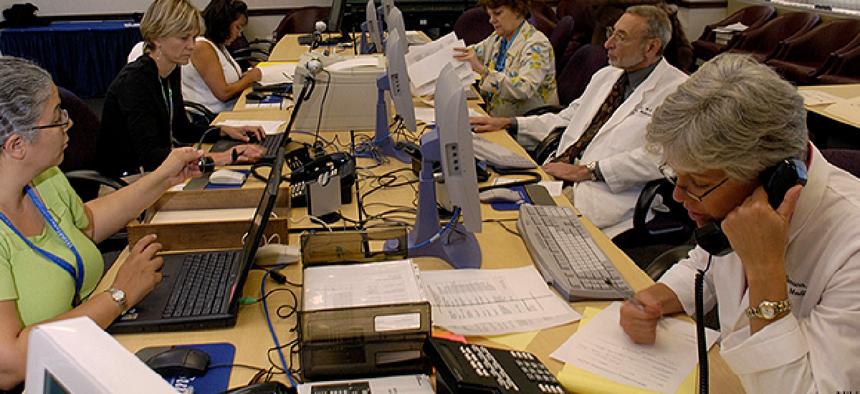Is the federal government ready for HD voice services?


Connecting state and local government leaders
Federal agencies would lead a global transition to IP-based high-definition voice services under a plan promoted by telecom advocates.
The federal government would lead a global transition from current standard voice services to IP-based high-definition voice services under a plan being promoted by the Voice Communication Exchange Committee (VCXC), a Washington, D.C., startup working to speed the rollout of HD voice over the public telephone network.
The goal of the group is to have 100 agencies making HD voice calls by the end of 2014.
In moving from standard voice definition calls over the public switched telephone network (PSTN), users will see a doubling in the resolution of voice calls, according to Daniel Berninger, founder of the VCXC.
“The ear can naturally hear frequencies in the range of 20 to 20,000 hertz,” he said. “Standard definition phone calls drop a huge part of that, so essentially we only hear between 200 and 3,300 Hz. HD voice will give us a range of 70 to 7,000 Hz.”
The effect for users will be to reintroduce into a phone call many of the nuances they take for granted in person-to-person speech, but which aren’t present in calls made over the PSTN -- and even less detectable in mobile phone calls.
That will make voice services competitive with many of the IP-based communication services that have sprung up since the development of the Internet and the Web, Berninger said, given that standard definition voice technology has not been upgraded for 80 years.
The impact of higher resolution HD voice shouldn’t be underestimated, he added. One of the reasons people have turned to text messaging and email for communications, he believes, is because of the poor experience they’ve had with standard voice, which has caused a 50 percent drop in the use of the PSTN just since 2000.
With HD voice there’s a much lower possibility of misunderstandings and a much higher level of communication, since many of the subtleties and inflections people take for granted in face-to-face speech would now be available.
For government agencies, the benefits of that could be substantial, Berninger said. “If you just take the basic notion of a call center and people trying to communicate through that with marginal voice quality, the communication process is injured, and there’s only so much you can do,” he said.
“People can’t understand each other, calls last much longer than they need to, thousands of people get teed off, and that goes down the line to communications between people within the agency,” he said.
HD voice will help the average person to communicate better, he said, but it will also mean major improvements for hearing-impaired callers as well as for the visually impaired, since they depend totally on what they hear.
It could also spark development of other services in the same way the move to HDTV did, which Berninger uses as a comparison for the transition to HD voice. That too produced a doubling in the image resolution on TVs, but it also prompted the subsequent development of cable TV services, voice over the Internet and to today’s revolution in streaming video and other IP-based, digital innovations.
Berninger, who calls himself an independent communication architect, was immersed in that revolution, starting in 1995 with helping the original assessment of Voice-over-IP for Bell Laboratories and as a force in the founding of VoIP communications companies such as Vonage as well as with the deployment of VoIP at government agencies such as NASA.
The reason why Berninger and the VCXC think the federal government could be a lead for the transition to HD voice is that it is already far along in its own move in that direction, with some 60 to 70 percent of agencies already using IP phones, if not HD voice.
If agency network infrastructures had to be upgraded to carry IP-based HD voice then it would be a much bigger job, Berninger said, but “tying together those agencies that have already deployed is, comparatively, a much smaller job.”
Once the initial process for moving those agencies over to HD voice has been decided, he said, it would take no more than a couple of hours to make the switch. Other than the technology requirements, he added, user training may be needed because the difference in the call experience will be so stark.
Berninger and the VCXC have presented their ideas to White House officials and are currently in talks with other agencies to get their opt-in approval for a HD voice transition. They’re also working with Verizon and AT&T as the main telecom providers for government and with Cisco as the major hardware vendor.
The organization is working to host an event May 12 that will, in real time, link a HD voice demonstration already running at the Federal Communications Commission with an HD voice network at another agency.
A global transition to HD voice could happen by 2018 or 2020, depending on how prospective milestones are decided, Berninger said. VCXC petitioned the FCC in February this year to issue a Notice of Inquiry on the migration to HD voice as part of the overall transition to IP networks.
What it is hoping to avoid is the need for any formal procurement process for the federal government move to HD voice, because that would slow things considerably. So far, Berninger said, they are working under the assumption that simply reaching out to CIOs or others at agencies, and the opt-in nature of the move, is all that will be required.
NEXT STORY: Disorder in the court? Check your beacon




